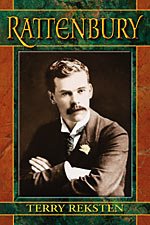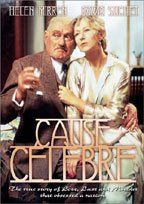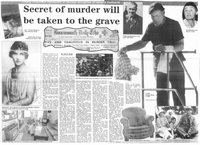Rattenbury Murder Redux
 One question that’s remained unanswered for 70 years is who really killed Francis Rattenbury, the architect of Victoria’s famous Parliament Buildings and Empress Hotel. As I mention in the Notoriety chapter, it’s always been suspected that the murderer was Rattenbury’s dope-addicted wife Alma, instead of George Stoner, their young chauffeur – who confessed to the crime, was sentenced to death, and then received clemency after Alma committed suicide.
One question that’s remained unanswered for 70 years is who really killed Francis Rattenbury, the architect of Victoria’s famous Parliament Buildings and Empress Hotel. As I mention in the Notoriety chapter, it’s always been suspected that the murderer was Rattenbury’s dope-addicted wife Alma, instead of George Stoner, their young chauffeur – who confessed to the crime, was sentenced to death, and then received clemency after Alma committed suicide.
In the 1997 edition of Terry Reksten’s biography of Rattenbury, she mentioned that in 1990, Stoner was busted for incedently assaulting a boy in a public toilet. (Police found the 73-year-old Stoner “naked in a cubicle, save for his socks, shoes and hat.”) I’d heard that Stoner had died not long ago. So I wondered, did he tell anyone on his deathbed what actually happened in the Rattenbury case? I contacted the public library in Bournemouth, the quaint English seaside town where the murder took place in 1935. (The Rattenburys moved there in 1929 because of its similarities to Victoria.) The case was the O.J. Simpson trial of its time, and according to the sheaf of articles the library sent me, it was still in the news – the Rattenbury’s Villa Maderia, for example, was just as plagued by break-ins today as it was after the famous trial, when it was ransacked by souvenir hunters. But it was mainly in the news because of Stoner, who chose to remain in Bournemouth despite his scandalous past.
I contacted the public library in Bournemouth, the quaint English seaside town where the murder took place in 1935. (The Rattenburys moved there in 1929 because of its similarities to Victoria.) The case was the O.J. Simpson trial of its time, and according to the sheaf of articles the library sent me, it was still in the news – the Rattenbury’s Villa Maderia, for example, was just as plagued by break-ins today as it was after the famous trial, when it was ransacked by souvenir hunters. But it was mainly in the news because of Stoner, who chose to remain in Bournemouth despite his scandalous past. The articles spelled out Stoner’s life after the trial. He got out of prison in 1942, joined the army, and participated in the D-Day invasion. He lay low after that, but resurfaced in 1977 at a London production of Cause Célèbre, Terence Rattigan’s play about the Rattenbury murder, which suggested that Stoner committed the dastardly deed. Stoner reportedly sat stock-still during the performance, and dodged reporters immediately afterward. A decade later he was in the news again, when he tried to stop the BBC from making a TV version of the play; the producers changed his character’s name to Bowman, and the play was aired in 1987. (A VHS copy is at the Greater Victoria Public Library.) Reporters continued to hound him. Finally, in 1999, he made a statement to the Bournemouth Daily Echo: “The whole crime was committed on an emotional basis. Both I and the lady involved were in a highly emotional state.”
The articles spelled out Stoner’s life after the trial. He got out of prison in 1942, joined the army, and participated in the D-Day invasion. He lay low after that, but resurfaced in 1977 at a London production of Cause Célèbre, Terence Rattigan’s play about the Rattenbury murder, which suggested that Stoner committed the dastardly deed. Stoner reportedly sat stock-still during the performance, and dodged reporters immediately afterward. A decade later he was in the news again, when he tried to stop the BBC from making a TV version of the play; the producers changed his character’s name to Bowman, and the play was aired in 1987. (A VHS copy is at the Greater Victoria Public Library.) Reporters continued to hound him. Finally, in 1999, he made a statement to the Bournemouth Daily Echo: “The whole crime was committed on an emotional basis. Both I and the lady involved were in a highly emotional state.”
That’s all he would say. Stoner died in a nursing home on March 24, 2000 – the 65th anniversary of the murder. So unless he kept a diary, we will likely never know who the real killer was.
UPDATE (July 17, 2006): A reader inquired why I said that Alma was "dope-addicted". A number of writers about the Rattenbury case have mentioned Alma's possible addictions. For example, Terry Reksten said this: “Alma may well have developed a drug dependency during the years she spent with the ambulance corps during the war. In battlefield hospitals both morphia and cocaine were used as anaesthetics and while morphia was known to be addictive, the properties of cocaine were not clearly understood. But cocaine was known to increase vitality and the capacity to work and since it was generally regarded as a harmless drug, Alma may have begun to use it to keep her going for long hours of unaccustomed hardship and labour .... [and] Alma certainly had an addictive personality. Self-denial was alien to her. One drink, more often than not, led to two or three more. She was a chain smoker who found it difficult to finish a meal without pausing between courses to smoke a cigarette. Rattenbury’s children, Frank and Mary, who were twenty and twenty-five at the time l’affaire Rattenbury became the talk of Victoria, remain convinced and take some comfort from their conviction that “dope” played a role in their father’s entrapment and they may be right.” (page 198) Sir David Napley's 1988 book, Murder at the Villa Madeira, also explores the question in depth. Stoner's defence was that he was addled from cocaine, but Napley argues that Stoner had no idea what cocaine looked like. Instead, the events of the trial suggested something else was going on: “Clearly, from the questions which Casswell [Stoner’s lawyer] put to her [Alma] in cross-examination, he must have been told by Stoner that she was in the habit of taking drugs .... The description which Stoner gave of the appearance of cocaine was an exact description of heroin. Moreover, Stoner’s solicitor at the committal proceedings put it to Dr O’Donnell, on Stoner’s instructions, that Alma was a drug addict. Taking those facts together, is it not possible that Alma was taking drugs and that one of them was heroin? In Canada there were a number of people who believed she had been on drugs and that this had originated from her contact with and experience of them during the war.” (page 221)
Sir David Napley's 1988 book, Murder at the Villa Madeira, also explores the question in depth. Stoner's defence was that he was addled from cocaine, but Napley argues that Stoner had no idea what cocaine looked like. Instead, the events of the trial suggested something else was going on: “Clearly, from the questions which Casswell [Stoner’s lawyer] put to her [Alma] in cross-examination, he must have been told by Stoner that she was in the habit of taking drugs .... The description which Stoner gave of the appearance of cocaine was an exact description of heroin. Moreover, Stoner’s solicitor at the committal proceedings put it to Dr O’Donnell, on Stoner’s instructions, that Alma was a drug addict. Taking those facts together, is it not possible that Alma was taking drugs and that one of them was heroin? In Canada there were a number of people who believed she had been on drugs and that this had originated from her contact with and experience of them during the war.” (page 221)
The reader also wanted to know more about Stoner's life after the trial. Above right is an excellent article from the January 28, 1999 Bournemouth Daily Echo summing up the case and its aftermath.


7 Comments:
I believe Alma's version - where is it known that she was a "dope addict"? Perhaps her guilt was only that her sexual relationship with this immature emotional young man caused him to commit the crime. I guess we will never know.
I would like to know more about Stoner's life after prison, and after the war.
I have to say that to whoever wrote this, you are choosing to ignore sources who have researched, studied and published books on this particular subject and you are blatently trying to build up a conspiracy based on your biast view... By the way there are a fair few spelling and grammar mistakes that you have made! Posted by someone who has studied this case. This is the only source from which has suggested that the verdict was questionable!
Someone has to point out that there are a whole whack of spelling and grammar errors in the comment accusing the OP of conspiracy theorizing and of butchering the English language. I'm just saying...it's pretty funny.
The TV production of 'Cause Célèbre' from 1987 starring Helen Mirren and David Morrissey was not made by the BBC but by Anglia Television and shown on ITV. It's been released on DVD in Region 2.
Hi I live in Bournemouth not far from 5 Manor Road where the murder took place, the house has remained unchanged since 1935. I never see a car outside and the house remaons in darkness, I wonder who owns it ! anyone know ?
I'd suggest that you read the transcript from the trial and associated police investigation reports. All of the evidence is there, and the evidence given by Irene Riggs, who was far more than just Alma Rattenbury's live in companion/maid, is instrumental in painting the picture of events in both March 1935 and the previous 4 years that she lived at the Rattenbury home. For the record, Irene Riggs was my grand aunt.
Interesting! I'd love to read the transcript and those reports. If you can share them, please email a link to my address in the upper right corner above. Thank you!
Post a Comment
<< Home